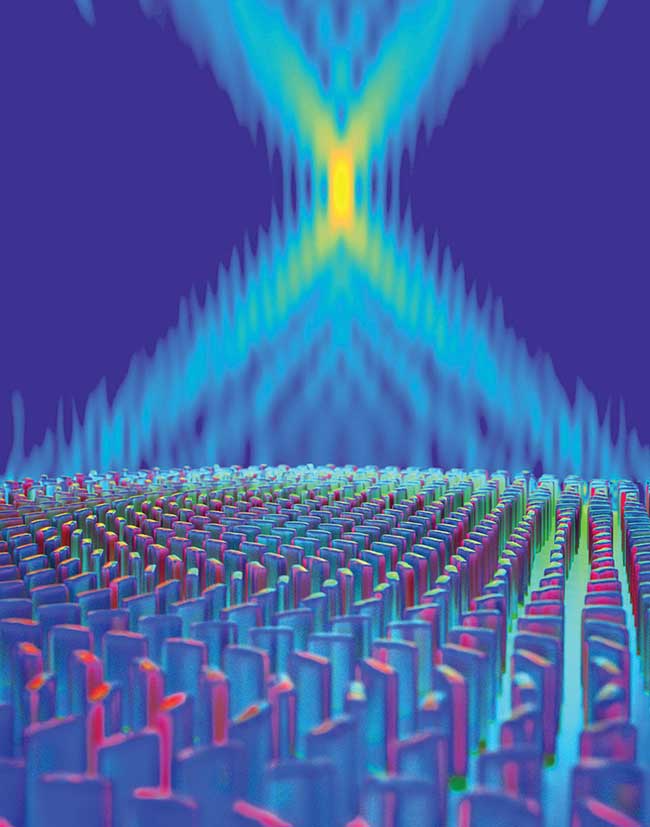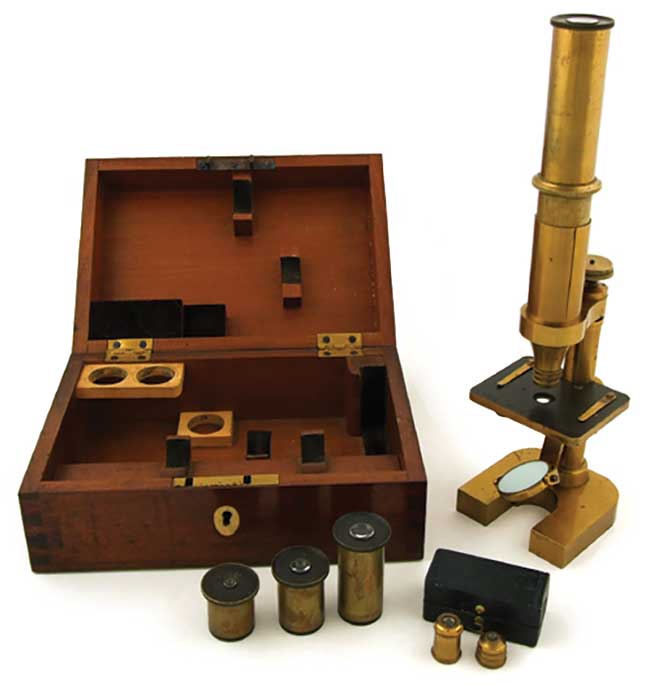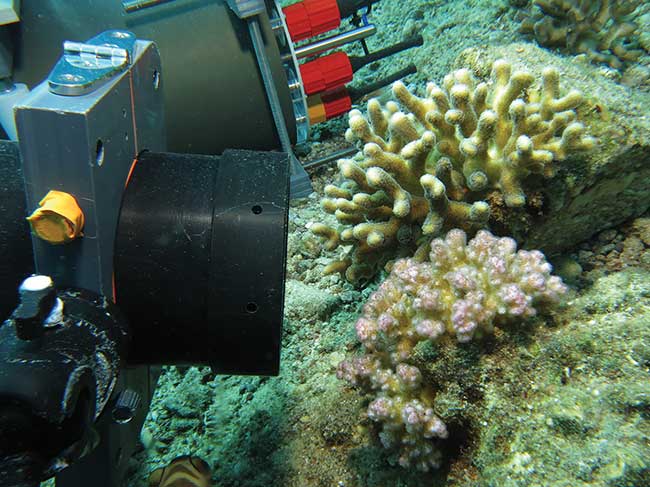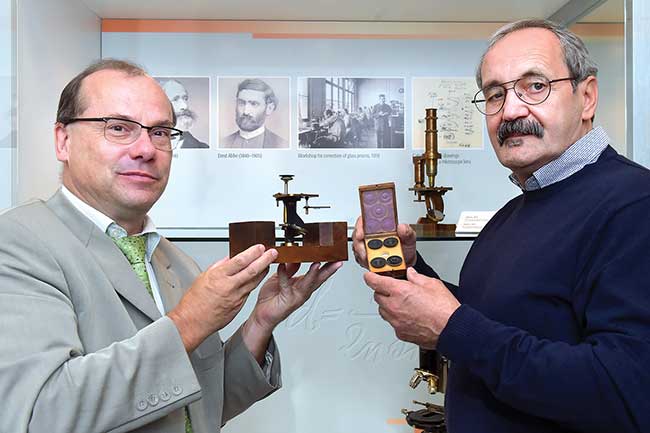
Art and Science: The Development and Impact of Optics
It is said that French painter Paul Cézanne (1839-1906) found inspiration in the optics of color and geometry, and that theories about light and vision informed his work. His paintings, in turn, influenced the work of other artists including Picasso and Braque. Long before Cézanne captured the French countryside on canvas, however, Isaac Newton, Thomas Young, Augustin-Jean Fresnel and others studied light, vision and optics, with far-reaching effects.

A Fresnel lens, named for its creator, Augustin-Jean Fresnel.
Theories of Light
The early study of optics dates back thousands of years to lens development in ancient Greece, Egypt and elsewhere. And in more recent history, the science of light and optics has advanced and flourished.
Fresnel was a 19th century French physicist whose research added to the establishment of the wave theory of light and polarization. The lens (and many variations of it) that bears his name was originally developed for use in lighthouses. It remains popular for many products today, such as imaging cameras, solar cells and light sources, as well as for applications in biophotonics, defense and security. Lighthouses also still use these lenses.
British physicist Young, who was also a physician studying optical and sense perception, performed work similar to that of Fresnel and ultimately reached the same conclusions relating to the wave theory of light. Beyond that, he established the principle of interference of light in the early 1800s — specifically, that light beams spread apart and overlap when passing through closely set pinholes on a screen. Bands of bright light thus alternate with bands of darkness.

A schematic showing the ultrathin meta-lens, which consists of titanium dioxide nanofins on a glass substrate. The meta-lens focuses an incident light (entering from bottom and propagating upward) to a spot (yellow area) that is smaller than the incident wavelength. Courtesy of Peter Allen/Harvard John A. Paulson School of Engineering and Applied Sciences.
Young’s work subsequently established the wave theory of light and polarization (to which Fresnel contributed). His theories additionally led to his study of how color is perceived and how thin films relate to wavelengths of light. Young’s findings, along with those of German physicist Hermann L.F. von Helmholtz, prompted the Young-Helmholtz three-color theory.
Carl Zeiss is another significant contributor to the field of optics. Founder of the Carl Zeiss AG and Carl Zeiss GmbH companies in Germany in the mid-1800s, he was a mechanic and optics product developer. Among his achievements were production of simple and compound microscopes, performed in a Jena, Germany, workshop he opened in 1846. Zeiss’s work also included design, manufacture and even repair of physical and chemical instruments. He collaborated with German physicist and mathematician Ernst Abbe whose contributions to optics include the design of lenses for optical microscopy. The pair together designed and fabricated advanced optical systems, such as an “illumination apparatus” in 1869 that was meant to improve the performance of microscope illumination.

A historical Zeiss compound microscope. Courtesy of Zeiss.
The recent acquisition by the Zeiss companies of a simple microscope that dates back to 1850 keeps that history alive today. It’s highly likely it was designed and built by Carl Zeiss himself, given its age and style, according to the companies’ archives department. The microscope has been very well-preserved — it is still secured onto a wooden base, and features original lenses, hand supports and a rotating diaphragm. This rare artifact is the first of its kind in the company’s collection of historical instruments, and is now part of a touring exhibition called Carl Zeiss: A Visionary Entrepreneur.
Modern R&D continues to build upon the optics foundation laid by Zeiss, Abbe and others.

The Benthic Underwater Microscope (BUM) is positioned to study coral competition. Courtesy of Jaffe Laboratory for Underwater Imaging/Scripps Institution of Oceanography, UC San Diego.
At the Scripps Institution of Oceanography at the University of California, San Diego, researchers have developed an underwater optical system for imaging the ocean and seafloor at microscale. The system — the Benthic Underwater Microscope (BUM) — aims to help scientists better understand the dynamic ecological processes taking place underwater on a microscopic scale. This assists in the study of animal behavior, and enables temporal and spatial analysis of ecologically significant phenomena at scales previously unseen in a natural environment.
A new IR optical sensor — the SCiO, developed by Israel-based startup Consumer Physics — allows the average consumer to instantly, and affordably, analyze physical materials; this includes learning how many calories and proteins are in a certain food, what a drink’s alcohol content is, whether a plant is healthy, or what exactly is in a medication. The device essentially scans the molecular fingerprint of an object, reading the chemical makeup of the materials. It’s nonintrusive and requires no physical contact with the object being scanned.

The SCiO miniature IR optical sensor by Consumer Physics allows the average consumer to instantly analyze things like how many calories and proteins are in a certain food, what a drink’s alcohol content is, whether a plant is healthy, or what exactly is in a medication. Courtesy of Consumer Physics.
At the front lines of discovery
Clearly things have advanced dramatically. Nick Vamivakas, an associate professor of quantum optics and quantum physics at the University of Rochester’s Institute of Optics, has observed several major evolutions in the field.
“The first is the availability of tremendous computing power and inexpensive data storage capability. The former has resulted in fantastic advances in computational imaging, as well as ‘smart’ systems that can process optical information in real time and react accordingly,” he said. “This marriage of optics hardware and sophisticated computing is continuing to make things that previously seemed impossible, possible.”
Vamivakas also mentions the industry’s increasing ability to “structure materials on exceedingly smaller length scales — roughly 100 times smaller than visible wavelengths,” making it possible to tailor nanoscopic quantum processes for best macroscale optical responses. Researchers and scientists are also now embracing the quantum features of light as a resource that can be exploited for information technology and sensing.

Dr. Wolfgang Wimmer, head of the Zeiss Archives (left) and Manfred Eichel display a simple microscope that dates back to 1850, likely built by Carl Zeiss himself. Courtesy of Jürgen Scheere/Zeiss.
There have been other global changes in the field over the past several decades, according to Bill Brocklesby, an associate professor at the Optoelectronics Research Centre of the University of Southampton, England. He got his start in the industry in the mid-1980s, and has seen some very specific transformations.
“I think that the biggest factor in changes to the way we work [in optics], for me, has been the advent of cheap pump photons. This has changed so many areas across the [optics] field in terms of light sources, and mostly has been driven by the rise of the laser diode, and continues to do so,” he said.
Professor Yasuhiko Arakawa, director of the University of Tokyo’s Institute for Nano Quantum Information Electronics and its Nanoelectronics Collaborative Research Center, has also seen changes and evolution in other areas of optics during his more than three decades as an industry player. Among them, quantum well lasers (quantum size effect lasers) for telecommunications and blue laser applications.
“The quantum dot lasers have a variety of superior performance to conventional lasers, such as high temperature operation, low-power consumption and low-cost productivity,” Arawaka said. He added that quantum dot lasers hold potential in silicon photonics applications, in particular.
Such technologies are expanding throughout many areas of the optics field.
“I think trying to develop platforms to enable quantum information science technologies has been exciting — both working toward physical implementations of quantum bits, as well as novel approaches to communication and security based on quantum states of light,” Vamivakas said, adding that such technology is opening pathways toward new approaches to sensing and metrology.
The future of optics
Such changes and advancement in optics are being relayed to the next generation of engineers. Monroe Community College in Rochester, N.Y., offers programs that aim to further develop the optics workforce. Alexis Vogt, an associate professor of optics and chair of the optics and photonics program there, said she and fellow professors bring optics innovations into classrooms and labs through curriculum, state-of-the-art equipment, and visits to area optics companies.
Nicholas Massa — a professor in the Laser Electro-Optics Technology Department at Springfield Technical Community College in Springfield, Mass., and a principal investigator for the U.S. National Science Foundation’s PBL Projects: Skills for the 21st Century — offers similar education and training in his classes and programs, emphasizing practical hands-on applications.
These types of optics training programs are popping up at community colleges and other such institutions worldwide. Educators and engineers hope that the changes and regular advancements in optics research and technologies will help attract more students to this quickly growing field.
“Optics really is an essential technology for our world, and will only get more so in the future,” said Alan Willner, 2016 president of The Optical Society, and Steven and Kathryn Sample Chair in Engineering at the University of Southern California, who has seen great transformation in optics technology and research in his 30-year career.
Vamivakas, who also has much experience in optics, sees the field going in several directions. He cites the potential for on-chip approaches that will become more commonplace. Augmented and virtual reality displays will continue to mature, as well, and should become more interactive and immersive. He added that smart systems that optimize optics hardware with data collection and analysis “in a holistic way” will lead to various technological developments.
“I think the major emerging application areas are in information technology — communication and computing, multi-functional optical sensors [and] interactive displays,” Vamivakas said. “I also expect unconventional optical elements will start to replace traditional lenses, mirrors, polarizers, etc.”
Brocklesby names imaging among optics-related fields as an area of future growth. Change in this area could include the wide-scale application of advanced mathematical techniques to relatively simple imaging devices, “changing the critical elements of an imaging system from finely engineered optics to effective algorithms.” An example of this is lens-less imaging, Brocklesby said, in which no objective lenses are used, although quantitative images can still be produced.
Quantum dot technology, such as quantum lasers, will become more crucial in the future, Arawaka said, for telecommunications and data communications. Other anticipations for the future of optics include advancements in materials science.
This discipline has taken a huge step forward in 2016, with the potential to replace glass lenses with metasurface materials that are not only more practical to manufacture, but can also produce aberration-free, subwavelength-resolution images. This planar metalens material could ultimately replace traditional optics in smartphones, digital cameras and microscopes, enabling further miniaturization of such devices. The work was performed in the lab of Harvard University physics and applied engineering professor Federico Capasso, whose other contributions to the field of photonics include the quantum cascade laser.
The research realm should evolve, too, according to Andrea Armani, an associate professor of both chemical engineering and materials science, and electrical engineering and electrophysics at the University of Southern California. As optical components, such as lasers and cameras, have become more accessible and easy to use, they have enabled numerous research efforts, she said, particularly interdisciplinary research in which optics serves as a tool of discovery. The synergy between component accessibility and identified technology is advancing the field, and as more components become broadly accessible, the field will continue to accelerate.
“The future is always shaped by the next generation,” Armani said. “Students today … want to develop technologies that solve societal problems. The future of optics will mirror … these goals.”
Published: September 2016